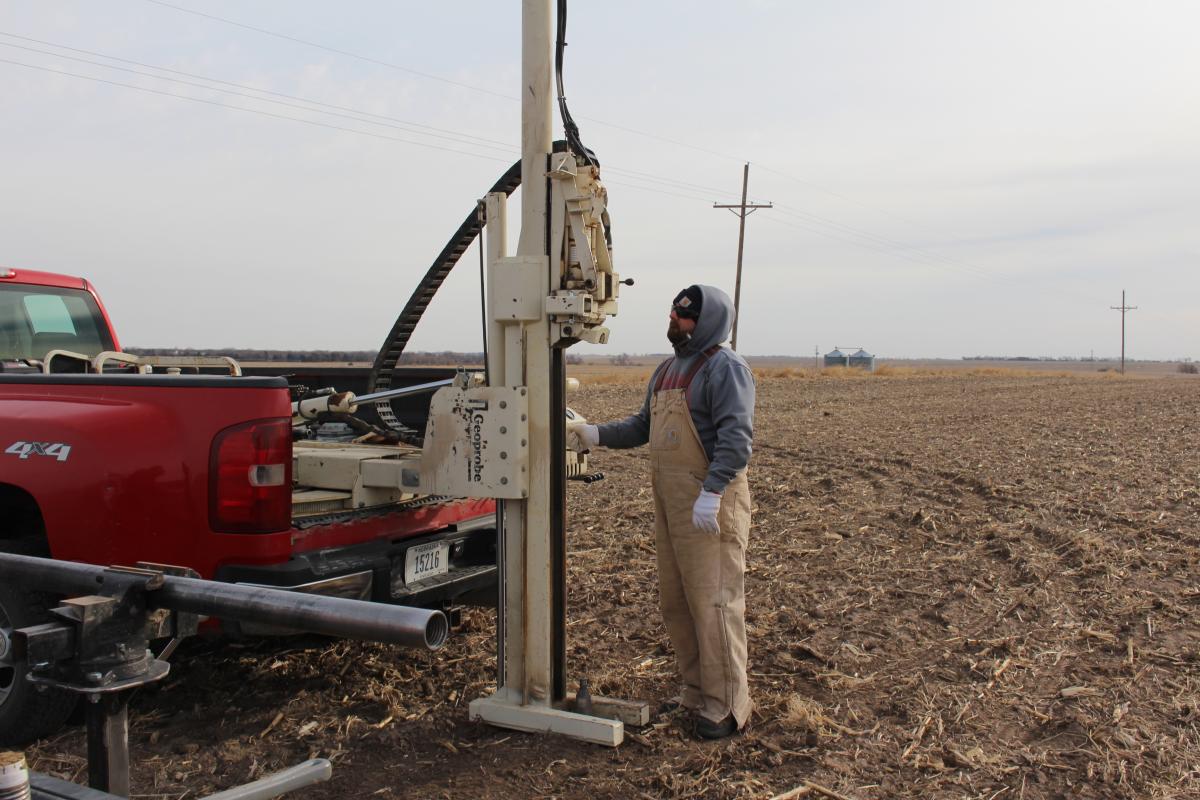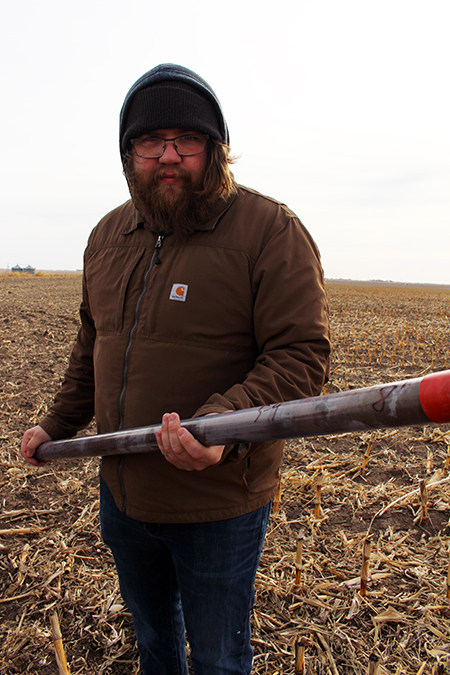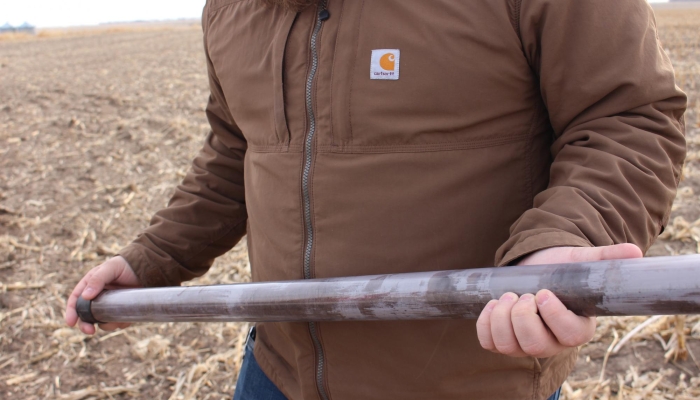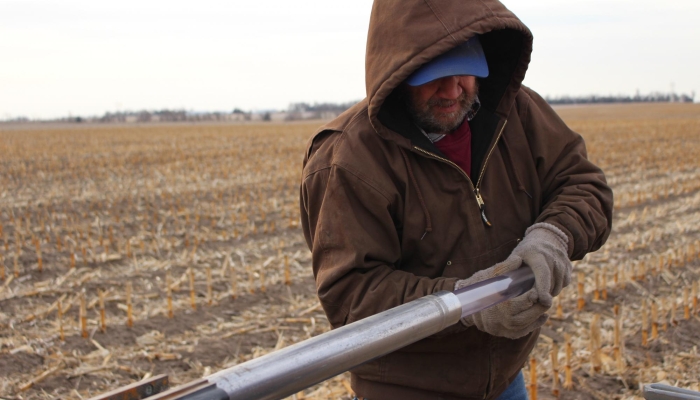Multiyear Study Looks at Nitrogen Load in Local Soils
Fertilizer pricing is top-of-mind for many involved in agriculture in Nebraska, so it is a great time to ask: are corn growers getting the maximum for nitrogen use efficiency? Are there management practices that could reduce nitrogen leaching, and thereby save farmers money as well as safeguard the groundwater supply? A research project from the University of Nebraska Lincoln in partnership with the Upper Big Blue Natural Resources District is looking for insights on nitrogen use in the past and present in the district and its long-lasting impact.
It’s a chilly spring morning in a cornfield near Bradshaw, Nebraska, where a strong wind whips last season’s dried husks through the air. Jacob Maslonka, water resources technician with the Upper Big Blue Natural Resources District, picks his way through the corn stubble to meet with a pair of researchers from the University of Nebraska. A motor rumbles loudly as the team drives collection tubes one after another into the soft soil of the field. The plastic tubes are encased in a metal sheath that is pressed into the ground with a drill rig mounted on the back of a pickup. When each sample tube is drawn back up, it’s full of dark earth—and information. The tubes are removed from the metal casings, capped, and labeled with collection data for later analysis of chemicals present as well as soil type and other characteristics.The cropland that Maslonka and the others are standing on is the property of a cooperating producer who has agreed to be part of a study that will examine the nitrate load in the vadose zone across the district. The collaboration between the NRD and the university will involve collecting shallow and deep soil samples* from up to 120 locations across the district over the next three years. These samples will be compared to samples from a similar study of the district in 1998. That data collected will be coupled with reporting from the participating producers about historic and current land management practices in the fields where the samples are collected. The results will give researchers insight into current nitrate levels, the movement of nitrate in the vadose zone, practices that are impacting nitrates in the vadose zone, and the future of groundwater quality in the district.
The vadose zone, also known as the unsaturated zone, is the soil between the crop root zone and the water table. Nitrogen from fertilizer can leach below the root zone beyond the usable range for crops to absorb, accumulating in the vadose zone. This is particularly true in instances of overapplication of fertilizer. When more fertilizer is applied than is needed by the crop or is applied too early to be used fully by the crop, the situation is primed for leaching. Over time, that nitrogen moves through the soil profile and ends up in the groundwater. The time it takes the nitrogen to reach the groundwater supply varies, based on soil type, precipitation/irrigation, and depth to water.
Not only does leaching represent a lost investment for the producers, but it also creates a contamination challenge for residents, as most Nebraskans’ drinking water comes from groundwater (rather than surface water) sources. Consuming water with elevated levels of nitrate can lead to adverse health outcomes including birth defects, and may be associated with some kinds of cancer.**
Remediating for nitrogen in groundwater is becoming an expensive problem for many rural Nebraskans. (A 2018 article from The Environmental Working Group, an advocacy organization, estimates that every $1 spent on prevention of nitrate contamination is worth $27 of remediation for the problem.) The cost for nitrogen remediation in drinking water is disproportionately high for rural residents, who typically have a lower median household income in addition to a small population base to defray the cost of municipal water improvements. In small towns, improved water systems can cost hundreds of dollars per person per year if new water treatment facilities must be constructed or additional wells drilled.
According to a 2019 study published by UNL faculty members on nitrogen use efficiency in Nebraska corn production, nitrogen leaching occurs more frequently when corn is grown continuously, rather than in rotation with other crops; where soils are sandier; where less efficient methods of irrigation are used; and when fertilizer is applied 100 percent preplant instead of 50 percent or more applied in-season.
In the Upper Big Blue Natural Resources District area, a few of these factors loom large. Many acres are farmed continuously with corn and a significant percentage of producers in Phase II & III management areas, where nitrate levels in water are higher, apply all of their nitrogen pre-plant (though this number has decreased somewhat in the last two years). On the plus side, soils tend to be less sandy than other parts of the state and more than half of irrigators utilize center pivots (instead of less efficient methods of irrigation such as furrow).
The Upper Big Blue NRD recommends a number of practices that can improve producers’ nitrogen use efficiency including chemigation and split application of fertilizer, as well as soil health practices such as no-till, crop rotations, and cover crops.*** Implementing the five principles of soil health can increase soil organic matter, as well as help soil retain moisture—meaning the system would need less fertilizer as well as less irrigation.

The current vadose zone study will provide valuable insight to the movement of nitrate through soils in the district and into the water supply, as well as which practices are working when it comes to best managing this problem. It’s a matter of human and environmental health, as well as one of financial health. Better practices will reduce the amount of nitrate in drinking water; they will also benefit producers, who may lose part of their investment due to leaching. While high fertilizer prices and supply chain challenges are causing added stress for the ag community, it’s the opportune moment to equip farmers with information to help them make wise decisions with regards to nitrogen use, as well as soil health practices that could reduce their dependence on conventional fertilizers.
A vadose zone study was recently conducted in the Hastings area by the same team from UNL that is conducting the current study in the Upper Big Blue NRD. The study drew samples from 32 locations and tested them against samples from the same locations five years later to see the rate of change of nitrate levels in the soil. The conclusion of that study was that current management practices in the Hastings area are not slowing the rate of increase of nitrate in the vadose zone. Lead researcher Dr. Dan Snow reported that while some samples reflected declines in soil nitrogen over that five-year period, most saw an increase. The average change across all locations was a 30 percent increase in nitrate-nitrogen in the soil. The highest level of increase was beneath gravity irrigated cropland. Increases were also seen in high density livestock feeding operations.
These findings suggest that the problem is not only historic overuse of fertilizer but continued need to improve nitrogen use efficiency and nutrient management in the Hastings area.
Beyond the Hastings area, there has been a steady increase in nitrogen concentration in groundwater samples, across the district. While there have been decreases or plateaus in some areas of the district, there has been an overall increase of 54 percent across the district in the last 20 years. Half of the district is now in a Phase II or Phase III management zone, meaning additional management is required due to the increased level of nitrogen in the groundwater.

Researchers with the current study of the vadose zone will collect samples for the next three years. Results will be analyzed throughout that time and will be first communicated to individual landowners. The aggregated information will be released to the public in 2024 and beyond. “This study is not meant to further regulations about nitrogen use,” said Maslonka. Instead, he hopes the study will examine if there are strategies for stopping or reversing the problem. “This study is an update on previous research but taking a current look at what the nitrate situation is in our district.” The study will also look at the concentrations of manganese, uranium, selenium, and arsenic in the soil, which could be indicative of a water quality problem in the future.
“It’s nice to know if your practices are working or not,” Maslonka added, noting that his hypothesis is that good management practices have slowed the rate of nitrogen contamination in the vadose zone and groundwater supply locally. “Management practices are better today than they were 50 years ago, but we need to continue to improve and be vigilant,” he said. “I hope this study will help farmers see the benefits of good management practices and it will encourage them to try new things on their land in the future…We don’t want to mess up their yield goal or balance sheet, but we want to show the value of the adoption of practices that reduce or reverse the rate of nitrogen leaching into the soil.”
If you have any questions or are interested in participating in the vadose zone study, feel free to contact Maslonka at the Upper Big Blue NRD at jmaslonka@upperbigblue.org.
***
*Shallow samples are 20’ in depth or to the water table. Deep samples are 100’ in depth or water table; If the water table is reached, water samples are also collected.
**Concerned about high nitrates in your water? Check out our free walk-in water testing program.
***These soil health practices may be eligible for incentive payments through the NRD and other agencies. District producers interested in these financial incentives should contact the NRD at info@upperbigblue.org or 402-362-6601.


